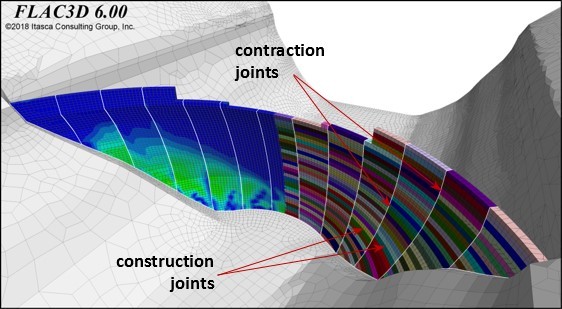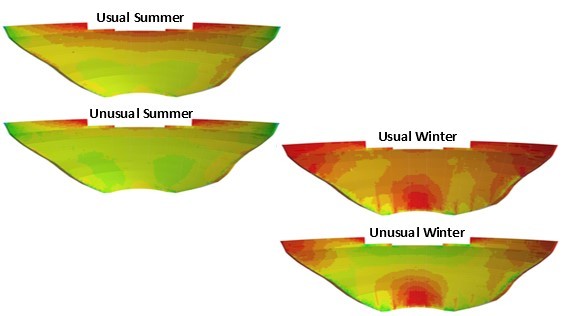Junction Dam
Project Description
Built between 1959 and 1961, Junction Dam is a double-curvature concrete arch dam located on Silver Creek in El Dorado County, California, just downstream from where Little Silver Creek and South Fork Silver Creek merge. The dam is in a relatively narrow canyon with steep sides and retains the Junction Reservoir. The dam is 168 ft high with a crest length of 525 ft. It has a reservoir capacity exceeding of 2,600 ac‑ft (at an elevation of 4,450 ft). It is part of the Upper American River Project (UARP), which is owned and operated by the Sacramento Municipal Utility District.
Itasca was hired to evaluate the performance of the dam undergoing usual, unusual, and extreme (seismic) loading conditions. Dam stability was assessed through the evaluation of compressive and tensile stresses and displacements in the dam using three-dimensional numerical modeling.
Itasca's Role
Itasca’s evaluation of Junction Dam included static loading, thermal loading, reservoir loading, and seismic loading using FLAC3D. Three sets of input ground motions were considered. Load cases and load combinations were applied according to the FERC Engineering Guidelines for Arched Dams. Three sets of input ground motions were considered in the dynamic analysis. Itasca evaluated the concrete dam and surrounding rock mass material properties. Several sensitivity analyses were conducted in order to bracket the predicted performance of the dam.
Particular attention was devoted to the structural joints of the dam with the vertical contraction joints modeled explicitly using interfaces. This approach permitted the evaluation of dislocation and separation. A Ubiquitous Joint constitutive model was adopted for the dam in order to consider the effect of the horizontal construction joints to capture the potential of zero tensile strength.
Project Results
Junction Dam was predicted to perform very well during usual, unusual, and extreme conditions. Maximum compressive stresses during static and dynamic conditions were well below the allowable compressive stresses, and while the dam may be subjected to some temperature-induced shrinkage and limited tensile stresses during winter, it remains stable even under the highest reservoir elevation. Seismically induced deformations of the order of 10 mm were predicted with tensile stresses being generally low, except in very local areas of higher tension.
Junction Dam was predicted to perform very well during usual, unusual, and extreme conditions. Maximum compressive stresses during static and dynamic conditions were well below the allowable compressive stresses, and while the dam may be subjected to some temperature-induced shrinkage and limited tensile stresses during winter, it remains stable even under the highest reservoir elevation. Seismically induced deformations of the order of 10 mm were predicted with tensile stresses being generally low, except in very local areas of higher tension.
Project Image(s)



